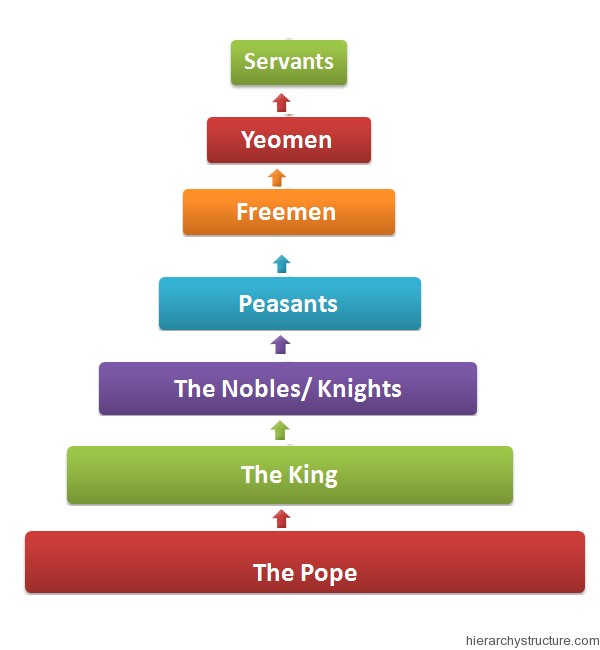Feudal hierarchy in the medieval age resembled a pyramid shape having the peasants (lower class) at the bottom of the pyramid where as king (lords) and the pope resided at the top of this pyramid.
This pyramid used to be widest at the lower levels and used to squeeze down the width while going upward. This pyramid of feudal system dictated everyone’s life. The intent of power increased from bottom to top with king possessing the maximum power.
This pyramid and the division of power were based on the belief that all the land belonged to the God. The king, who ruled the country with the God’s wish, could use this land.
King granted the land to the knights and nobles in return for the military services whereas nobles and knights further granted the land to peasants, who belonged to lower class, for agriculture purpose and in return expected some desirable rent and their personal services. This way land got subdivided from higher classes to lower and so got the privileges.
The pyramid of the feudal system was broadly categorized as the pope, the king, the knights and nobles, peasants, freemen, yeomen, servants. These are discussed briefly as below:

- The Pope – The king was considered having supreme power and ruled the country. But in this pyramid, there was a person who got the right to interfere even in the king’s decision when the time called for it, the pope, considered God’s voice on earth. The pope even possessed the power to announce a judgment against the king and place some other royal authority at the place of king just for the benefit of kingdom.
- The King – The king possessed all the land along with the extreme power in the kingdom. Except the pope no one was able to question a king’s decision. All were to bow before the king and his ultimate decisions. It was considered an honor to sacrifice one’s life for the king.
- The Nobles/ Knights–Next to the king, came in the pyramid the nobles and knights. They were loyal authorities of the king and king granted them his land in return for the military services.
- Peasants – The knights and nobles further granted their land to the lower class called peasants for agriculture purpose and in return expected some special personal services. Peasants were also bound to pay rent to the nobles.
- Freemen – These were the peasants who did not take the land from the nobles and were involved in the trade. They were bounded for little services to the higher class as compared to the peasants.
- Yeomen – These were the peasants who worked very hard to possess a land of their own. They did not take land on rent from the nobles.
- Servants–These were the men and women who were like slaves to the king and nobles. Their duty was to take care of the day to day tasks of the higher class.
Know about the Egyptian Feudal Hierarchy.
